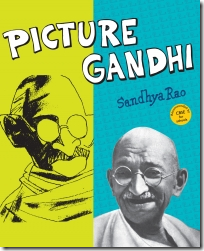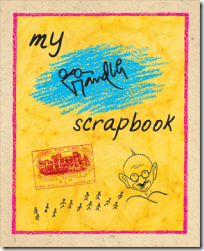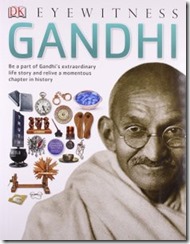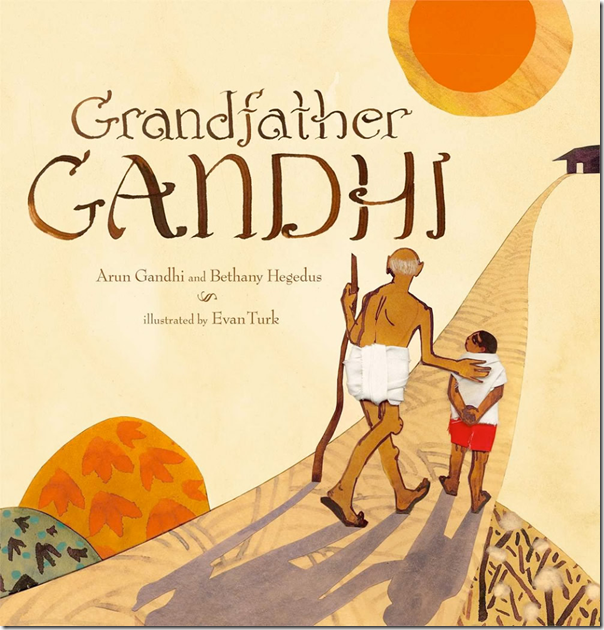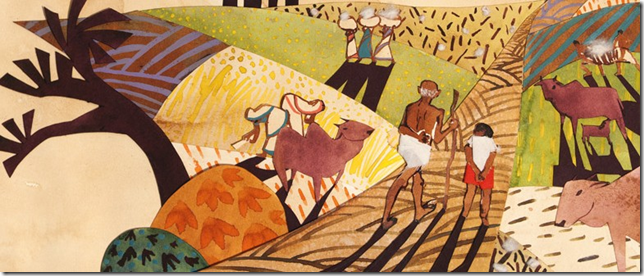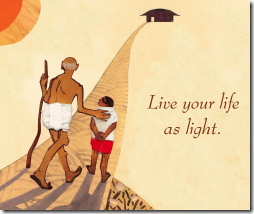Ahead of the Swachh Bharat campaign which was launched on 2nd October, I was cleaning out the shelves at Bookworm, collecting all the Gandhi book we have and looking forward to a week of reflection and remembering the Mahatma.
When we first procured Picture Gandhi written by Sandhya Rao and published by Tulika, Chennai; we were so happy to find a book that was laid out with the reader in mind ! The book has a terrific balance in it’s illustrative quality and so many precious findings about Gandhiji that we explored it repeatedly. In time, we had Sandhya Rao visit us at Bookworm and she left a brief PPT with me where images and more images including photographs not in the book were shared. I used that PPT for many years, leaving children and parents with My Gandhi Scrapbook for memory making and keeping.
This August, I found a DK book from the EYEWITNESS series titled Gandhi. Ofcourse I swooped it up and have been exploring it slowly by myself and also using parts of it with groups we work with.
The book has that stunning photo quality and good research notes that DK is famous for, but what we have all loved and used is the pull out poster that captures many facts and finds about Gandhi and provokes curiosity and questions when displayed. When I think about this set of books they all objectify the Gandhi. Keeping him up there and out there and telling us more and more about the Mahatma.
Our Gandhi collection immediately got better and refreshed when I saw My Grandfather Gandhi in a bookstore. I have looked at it repeatedly, read it aloud to my own and others, sneaked behind unsuspecting visitors to the Library and said, you can’t leave without reading this one !
I often wonder, what makes a good book and since this idea of ‘good’ is so elusive and hard to define, I speak in book tiles. Read this or read that and experience a good book. My Grandfather Gandhi, for me at this point in time is that – a good book!
It is both personal and informative. It has that remarkable quality of within and without and it is told from the point of view of Arun Gandhi, a child and a Grandson of the Mahatma.. The book engages not only because it is a Gandhi story but because it deals with human emotions of anger, of wanting attention. It resonates with the legacy of identity that must come to those who are born onto parents of distinctiveness and it stays with you long after the final full stop.
My Grandfather Gandhi is visually stunning, graphically well imagined and laid out and is arresting in capturing the heat and the energy of Sevagram and the heat and the energy in Arun’s mind as he grapples with understanding who he is in the light of his Grandfather!
Flavia our experienced Resource Person read this book at St. Thomas Boys School, Aldona and she reports that “The students in class IV, seemed to understand Arun’s rage during the game and that he was then ashamed about it. They realised that Gandhiji sent his aide away when Arun wanted to discuss this matter with him and gave time to Arun. They reflected on new words in the text like ” aide, striding, whisked, spindle “. When asked to describe what part of the story they liked best. The answers included: Arun’s anger at being tripped, Gandhi’s advice that he too got angry at times, Arun being teased by boys at the ashram, Gandhiji sweeping floors, Arun wondering whether he would be able to live up to the Gandhi name.”
The story was quite long, with lots of hidden meanings – why did the child feel that he was not fit to carry the Gandhi name, why the child was not happy that he felt anger, how anger and lightning/electricity can be harnessed for good. This class had to be prompted a bit, for them to think further than just the words – and a story like this allowed that thinking to surface. “
As our story planning and read alouds move into the new season, we carry with us this message from all our Gandhi books and will keep reading burning bright !

